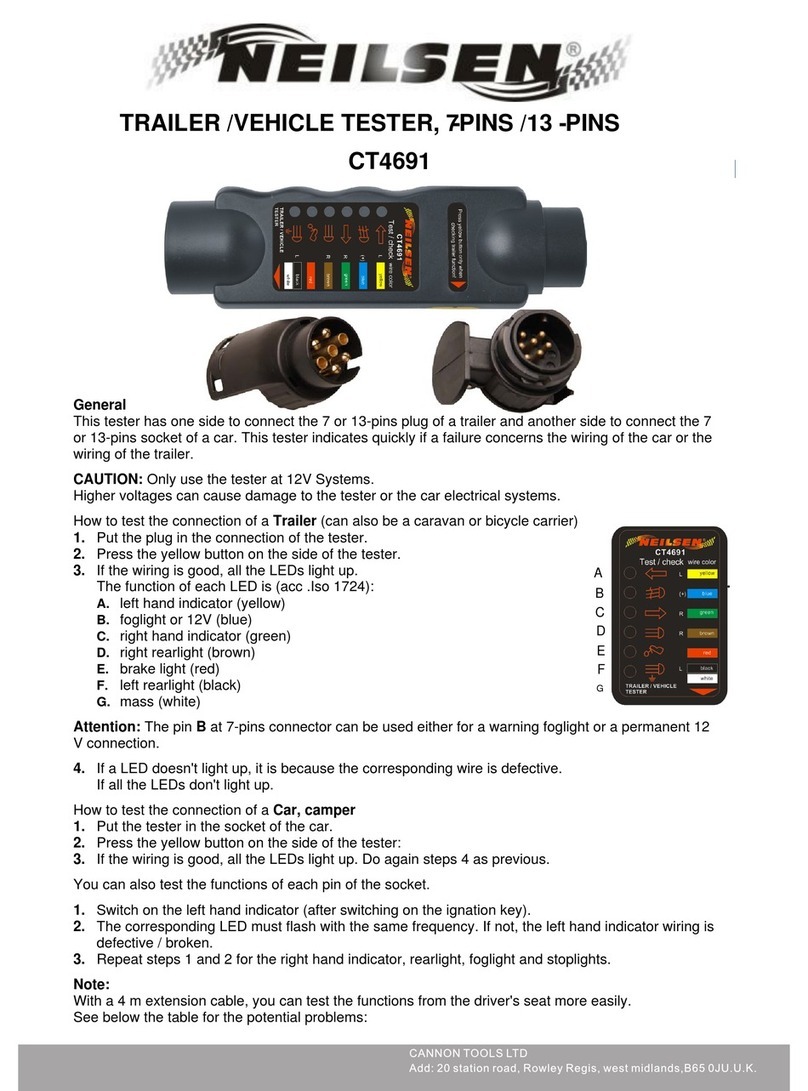
3
•Maintain tools with care. Keep the Battery Tester clean for better and safer performance.
Follow instructions for changing accessories. Inspect product cords periodically, and if
damaged, have them repaired by an authorized technician. The handles must be kept clean,
dry, and free from oil and grease at all times.
•Disconnect power. Disconnect from battery when not in use.
•Avoid unintentional starting. Be sure the switch is in the “Off”position when not in use.
•Stay alert. Watch, what you are doing, use common sense. Do not operate any product when
•Check for damaged parts. Before using any product, any part that appears damaged should
be carefully checked to determine that it will operate properly and perform its intended
Check for alignment and binding of moving parts; any broken parts or mounting fixtures; and
any other condition that may affect proper operation. Any part that is damaged should be
properly repaired or replaced by a qualified technician. Do not use the product if any switch
does not turn “On” and “Off ” properly.
•Guard against electric shock. Prevent body contact with grounded surfaces such as pipes,
radiators, ranges, and refrigerator enclosures.
•Replacement parts and accessories. When servicing, use only identical replacement parts.
Use of any other parts will void the warranty. Only use accessories intended for use with this
tool. Do not operate product if under the influence of alcohol or drugs. Read warning labels if
taking prescription medicine to determine if your judgment or reflexes are impaired while
taking drugs. If there is any doubt, do not operate the product.
•Maintenance. For your safety, service and maintenance should be performed regularly by a
•Beware of hot surfaces. The cables, clamps, and batteries may become hot during use.
Avoid touching without exercising care to avoid harm and injury.
•Avoid extreme heat. Do not create smoke, flames, or sparks near batteries. Battery acid is
•Pacemaker safety warning. People with pacemakers should consult with their physician(s)
before using this product; operation of equipment in close proximity to a heart pacemaker
could cause interference or failure of the pacemaker.
•Load Switch Warnings. Release the Load Switch before connecting, disconnecting, or
rocking clamps. Do not depress the Load Switch for longer than ten seconds.
Always read and adhere to all warnings and instructions provided by the manufacturer of
the battery being tested. This product contains or, when used, produces a chemical known to
Cause cancer and birth defects or other reproductive harm. The warnings, cautions, and
Instructions discussed in this instruction manual cannot cover all possible conditions and
situations that may occur. Persons who are not familiar with the operating instructions, children
or persons under the influence of alcohol, drugs or medication should not operate this
If battery fluids contact your skin, face, or eyes, immediately flush with plenty of fresh water,
and then contact a doctor.



























